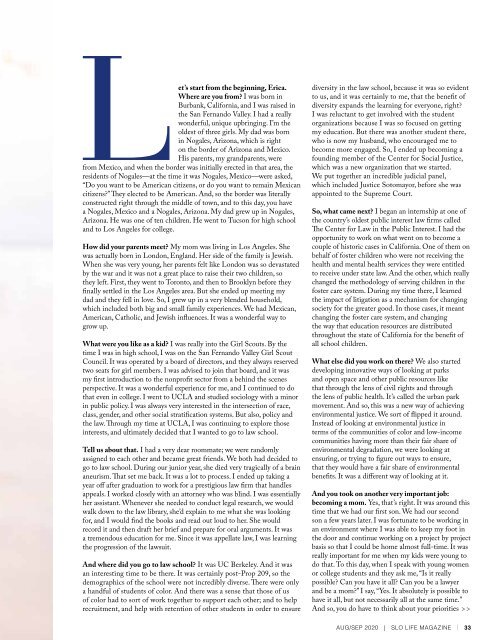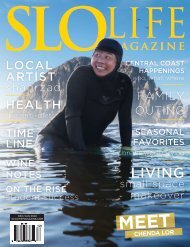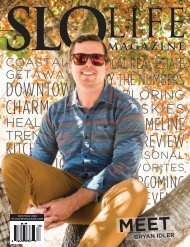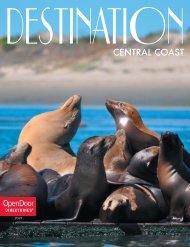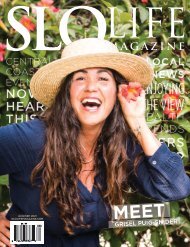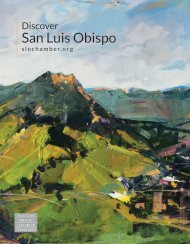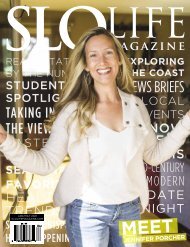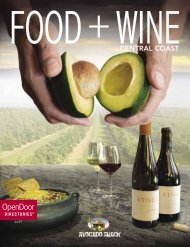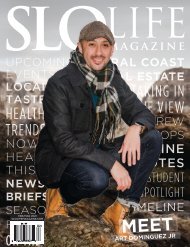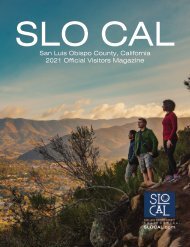SLO LIFE Magazine AugSep 2020
You also want an ePaper? Increase the reach of your titles
YUMPU automatically turns print PDFs into web optimized ePapers that Google loves.
et’s start from the beginning, Erica.<br />
Where are you from? I was born in<br />
Burbank, California, and I was raised in<br />
the San Fernando Valley. I had a really<br />
wonderful, unique upbringing. I’m the<br />
oldest of three girls. My dad was born<br />
in Nogales, Arizona, which is right<br />
on the border of Arizona and Mexico.<br />
His parents, my grandparents, were Lfrom Mexico, and when the border was initially erected in that area, the<br />
residents of Nogales—at the time it was Nogales, Mexico—were asked,<br />
“Do you want to be American citizens, or do you want to remain Mexican<br />
citizens?” They elected to be American. And, so the border was literally<br />
constructed right through the middle of town, and to this day, you have<br />
a Nogales, Mexico and a Nogales, Arizona. My dad grew up in Nogales,<br />
Arizona. He was one of ten children. He went to Tucson for high school<br />
and to Los Angeles for college.<br />
How did your parents meet? My mom was living in Los Angeles. She<br />
was actually born in London, England. Her side of the family is Jewish.<br />
When she was very young, her parents felt like London was so devastated<br />
by the war and it was not a great place to raise their two children, so<br />
they left. First, they went to Toronto, and then to Brooklyn before they<br />
finally settled in the Los Angeles area. But she ended up meeting my<br />
dad and they fell in love. So, I grew up in a very blended household,<br />
which included both big and small family experiences. We had Mexican,<br />
American, Catholic, and Jewish influences. It was a wonderful way to<br />
grow up.<br />
What were you like as a kid? I was really into the Girl Scouts. By the<br />
time I was in high school, I was on the San Fernando Valley Girl Scout<br />
Council. It was operated by a board of directors, and they always reserved<br />
two seats for girl members. I was advised to join that board, and it was<br />
my first introduction to the nonprofit sector from a behind the scenes<br />
perspective. It was a wonderful experience for me, and I continued to do<br />
that even in college. I went to UCLA and studied sociology with a minor<br />
in public policy. I was always very interested in the intersection of race,<br />
class, gender, and other social stratification systems. But also, policy and<br />
the law. Through my time at UCLA, I was continuing to explore those<br />
interests, and ultimately decided that I wanted to go to law school.<br />
Tell us about that. I had a very dear roommate; we were randomly<br />
assigned to each other and became great friends. We both had decided to<br />
go to law school. During our junior year, she died very tragically of a brain<br />
aneurism. That set me back. It was a lot to process. I ended up taking a<br />
year off after graduation to work for a prestigious law firm that handles<br />
appeals. I worked closely with an attorney who was blind. I was essentially<br />
her assistant. Whenever she needed to conduct legal research, we would<br />
walk down to the law library, she’d explain to me what she was looking<br />
for, and I would find the books and read out loud to her. She would<br />
record it and then draft her brief and prepare for oral arguments. It was<br />
a tremendous education for me. Since it was appellate law, I was learning<br />
the progression of the lawsuit.<br />
And where did you go to law school? It was UC Berkeley. And it was<br />
an interesting time to be there. It was certainly post-Prop 209, so the<br />
demographics of the school were not incredibly diverse. There were only<br />
a handful of students of color. And there was a sense that those of us<br />
of color had to sort of work together to support each other; and to help<br />
recruitment, and help with retention of other students in order to ensure<br />
diversity in the law school, because it was so evident<br />
to us, and it was certainly to me, that the benefit of<br />
diversity expands the learning for everyone, right?<br />
I was reluctant to get involved with the student<br />
organizations because I was so focused on getting<br />
my education. But there was another student there,<br />
who is now my husband, who encouraged me to<br />
become more engaged. So, I ended up becoming a<br />
founding member of the Center for Social Justice,<br />
which was a new organization that we started.<br />
We put together an incredible judicial panel,<br />
which included Justice Sotomayor, before she was<br />
appointed to the Supreme Court.<br />
So, what came next? I began an internship at one of<br />
the country’s oldest public interest law firms called<br />
The Center for Law in the Public Interest. I had the<br />
opportunity to work on what went on to become a<br />
couple of historic cases in California. One of them on<br />
behalf of foster children who were not receiving the<br />
health and mental health services they were entitled<br />
to receive under state law. And the other, which really<br />
changed the methodology of serving children in the<br />
foster care system. During my time there, I learned<br />
the impact of litigation as a mechanism for changing<br />
society for the greater good. In those cases, it meant<br />
changing the foster care system, and changing<br />
the way that education resources are distributed<br />
throughout the state of California for the benefit of<br />
all school children.<br />
What else did you work on there? We also started<br />
developing innovative ways of looking at parks<br />
and open space and other public resources like<br />
that through the lens of civil rights and through<br />
the lens of public health. It’s called the urban park<br />
movement. And so, this was a new way of achieving<br />
environmental justice. We sort of flipped it around.<br />
Instead of looking at environmental justice in<br />
terms of the communities of color and low-income<br />
communities having more than their fair share of<br />
environmental degradation, we were looking at<br />
ensuring, or trying to figure out ways to ensure,<br />
that they would have a fair share of environmental<br />
benefits. It was a different way of looking at it.<br />
And you took on another very important job:<br />
becoming a mom. Yes, that’s right. It was around this<br />
time that we had our first son. We had our second<br />
son a few years later. I was fortunate to be working in<br />
an environment where I was able to keep my foot in<br />
the door and continue working on a project by project<br />
basis so that I could be home almost full-time. It was<br />
really important for me when my kids were young to<br />
do that. To this day, when I speak with young women<br />
or college students and they ask me, “Is it really<br />
possible? Can you have it all? Can you be a lawyer<br />
and be a mom?” I say, “Yes. It absolutely is possible to<br />
have it all, but not necessarily all at the same time.”<br />
And so, you do have to think about your priorities >><br />
AUG/SEP <strong>2020</strong> | <strong>SLO</strong> <strong>LIFE</strong> MAGAZINE | 33


